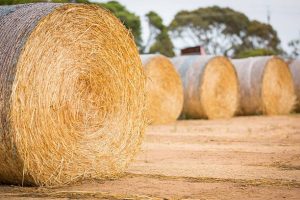One of the best ways to save money on hay baling is by using biodegradable twine. This type of twine is biodegradable and can also be used in packing cattle feed. It is also less expensive than other materials like polypropylene and is more durable. In addition, it is also more environmentally friendly.
Sisal twine is biodegradable
 Sisal twine is an environmentally friendly option for hay baling. It’s biodegradable and digestible, unlike plastic or net wrap, which can litter feedlots and barns for years. A North Dakota State University study showed that plastic twine and net wrap remained in the cow’s rumen for up to 14 days, but sisal twine decomposes much quicker.
Sisal twine is an environmentally friendly option for hay baling. It’s biodegradable and digestible, unlike plastic or net wrap, which can litter feedlots and barns for years. A North Dakota State University study showed that plastic twine and net wrap remained in the cow’s rumen for up to 14 days, but sisal twine decomposes much quicker.
Another biodegradable alternative to sisal twine is Envirocord, a biodegradable baling twine made from renewable resources. This twine is odourless, water-proof, and solar-degradable after three months. In addition to its biodegradability, Envirocord has a comparable tensile strength to sisal twine.
Cordex is a leading manufacturer of sisal twine. The natural fibres of sisal are biodegradable, and Cordex twine is treated to resist animal problems and rot. It’s also highly affordable. Plastic twine is also available but doesn’t degrade like sisal, so it’s a good choice for outdoor storage applications. On the other hand, polypropylene-based twine has a tensile strength of 130 pounds. Therefore, it’s perfect for applications where the twine will be exposed to the elements.
Another option for hay baling is solar-degradable twine, which combines the advantages of sisal and synthetic twine. It can hold more bales before decomposing and can be used for bigger bales. However, the twine should be strong enough for the size of the bale.
It is durable
For baling hay, durable twine is the best choice. There are several kinds of twine available, but two of the most common are sisal and polypropylene. Both are durable and resistant to rot. Choosing the right one depends on the use and application of the bale.
You can find durable baling twine in different colours and strengths, depending on your needs and the baling machine you use. Generally, black baling twine is the most durable and is popular in climates with high solar radiation. However, if you do not need to use black twine, you can opt for yellow, white, red, orange, or green twine.
If you want to purchase a high-quality twine for your hay baling project, you can opt for single-ply twine, which is made of polypropylene and is UV treated. This twine is resistant to rot and mildew and is biologically harmless to livestock.
Baling twines are often twisted into a rope shape and then packaged in coils and pallets for commercialisation. Several companies manufacture baling twine. The most well-known one is Reyenvas, which is part of the Armando Alvarez Group. Reyenvas produces baling twines specifically for baling machines. Their products meet the highest standards and are certified by leading baling machinery manufacturers.
High-quality baling twine is essential for achieving optimum press density and cost-per-bale. It should also be UV-protected and resistant to knotting. And lastly, it must be made of high-quality raw materials. With these qualities, durable baling twine can ensure that you have high-quality hay bales and a low overall operating cost.
Durable baling twine can be used for a variety of baling projects, including the production of hay bales. It is stronger than bale wire and can withstand the weight of large animals. It is also more cost-effective and biodegradable than metal wire. As a result, it makes it a better choice for many farmers.
Polypropylene-based baler twine is an excellent choice for farmers looking for quality and durable hay baling twine. This plastic is safe to use, and it is also very environmentally friendly. The plastic is also UV-resistant, and its lightweight and dense material make it an ideal choice for baler twine.
It reduces storage and handling losses
Bales should be placed in rows to reduce handling and storage losses. Choose a location where the ground drains well. Place the bales end-to-end in long rows from northwest to southeast. The distance between bales should be at least 10 feet. If possible, place rows away from fields and fences.
Bales should be tied with plastic twine. Net wrap or untreated sisal twine are also suitable options. However, avoid using treated twine, as the fibres will degrade the plastic film and cause significant storage and handling losses. The typical bale size is four feet wide by four feet long, weighing between 900 and 1300 pounds. Larger bales require less film per ton but are more challenging to handle.
The storage and handling losses associated with hay baling vary from region to region. In Wisconsin, for example, a study found that bales wrapped with twine lost 11 percent of dry matter, while net-wrapped bales lost 7.3 percent. To minimize losses, producers should consider the amount of storage and handling facilities they have available. Additionally, they should use storage facilities that allow water to drain from the bales.
Bales should be wrapped with a minimum of six wraps, which may vary depending on field conditions. More wraps are required if the bales are stored for an extended period. The wrap must be applied evenly and with uniform tension. Ideally, wraps should be applied in two-layer increments. The overlap between successive layers should be 50% or less.
In large round bales, net wrap is a better choice than twine. It has many benefits, including increased speed, lower handling losses, water-shedding ability, and lower costs. However, the cost of the material used in a net wrap is higher, which is an added expense.